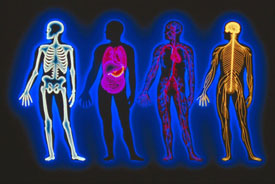 We’ve talked before about the link between your spine and the healthy function of the rest of your body.
We’ve talked before about the link between your spine and the healthy function of the rest of your body.
This isn’t because we work as Chiropractors in Kanata, but the simple fact that everything in your body is connected. The spinal cord and the nerve roots through which your brain manages the function of all your bodily processes run through your spine. If the spine is misaligned, it puts these soft tissues under stress. This can impact your body’s function in various ways.
Take the example of scoliosis.
Scoliosis is a deformity in which the spine becomes abnormally rotated and curved sideways. In severe cases, this can come to push the lungs and heart against the rib cage, with obvious negative health effects.
There are several types of scoliosis. Degenerative scoliosis results from wear and tear on the discs of your spinal column and the facet joints where two vertebrae meet. Degenerative scoliosis can cause:
- Back pain that is worse while sitting or standing versus lying down
- Electric shock-like pain
- Numbness
- Weakness in one or both legs
Another condition that can develop as a result of scoliosis is spinal stenosis.
Spinal stenosis is also common in people over 50 who are suffering from spinal degeneration. This is a narrowing of the spinal canal – those holes through the middle of your vertebrae through which your spinal cord passes. Think of doughnuts on a rope.
Spinal stenosis causes the spinal cord and the nerve roots to become compressed.
If this occurs in the neck, cervical stenosis, common effects include:
- Numbness or clumsiness of the hands
- Balance and coordination problems, such as leg stiffness or tripping while walking
- Weakness or incoordination of the arms and hands
- Difficulty with fine motor control for things like buttoning, tying, writing, and typing
If this occurs further down your back, lumbar stenosis, you may suffer:
- Low back pain
- Pain, tingling, or weakness/heaviness in one or both legs that becomes worse with standing or walking.
- Weakness, numbness, or pain that radiates to the buttocks and legs.
But here’s the thing: a subluxation – a misalignment of the vertebrae in your spine – puts similar stress on your spinal cord and nerve roots.
What we learned from 50 dogs
We’ll reference again a Japanese study of 50 dogs we looked at last summer. Their spines were put under gradual traction to induce the kinds of misalignments of the spine we see in many of our patients. The integrity of the spinal cord was closely monitored throughout. It was evident that a spine that is out of alignment does put stress on the spinal cord and makes it more vulnerable to compressive forces, such as those that may be caused by a bulged or herniated disc. Another study with dogs showed that, if you ease this kind of stress on the spinal cord, damaged tissue can heal faster.
In other words, the impairment inhibits your body’s natural healing. Spinal misalignments that are unaddressed long term will lead to degeneration of vertebrae and herniated discs, elevate pressure and stress on the spinal cord and connected nerve tissues, and result in a buildup of scar tissue.
The result? Impairments to the healthy function of your sensory, motor, and autonomic nervous systems. This includes the sympathetic nervous system. This is the system that stimulate the body’s instinct for “flight or fight” in response to a perceived threat. It also maintains homeostasis -the healthy balance of all the biochemical activities that are always taking place in your body.
If your sympathetic nerve fibers are not functioning properly, you will not function properly. How can this not impact your mood, energy levels, sleep patterns, and organ function?
How these things may or may not be impacted depends on where, how, and to what degree your spinal cord and the nerve roots in question are being stressed.
It’s about more than just back pain
With most chronic conditions, symptoms, the severity of symptoms, and any resulting permanent damage accrues gradually over time. The negative health effects can be felt long before a formal diagnosis of the condition is made by a healthcare professional.
But therein lies the trap.
Because it is often a slow and insidious process, we fail to recognize the warning signs. We come to accept chronic pain, lost mobility, and poor function as our new normal.
It doesn’t have to be. Chiropractic can often treat more than just the pain in your back, because that pain might only be the most obvious symptom of a subluxation that is causing problems elsewhere in your body, too.
